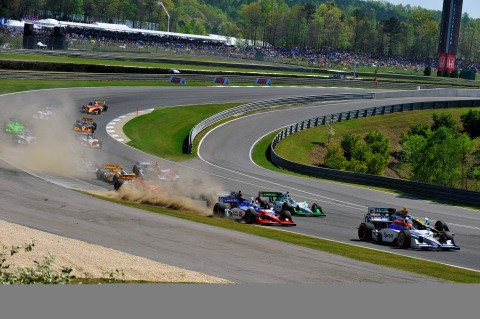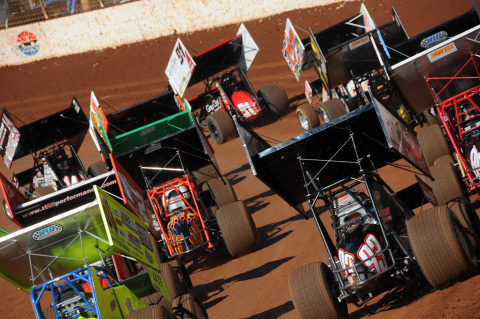The Way It Is/ Struggliing for an identity
by Gordon Kirby Most sports are pretty straightforward. There's a stick and/or ball, some fairly basic equipment for the players and a simply delineated playing field that can be seen by most or all the spectators. The big leagues--the NFL, Major League Baseball, the NBA, PGA, NHL and international organizations like FIFA, et al--define and control the sport and young kids follow a pretty clear path from their local little league playing fields to the brand name big leagues.
Most sports are pretty straightforward. There's a stick and/or ball, some fairly basic equipment for the players and a simply delineated playing field that can be seen by most or all the spectators. The big leagues--the NFL, Major League Baseball, the NBA, PGA, NHL and international organizations like FIFA, et al--define and control the sport and young kids follow a pretty clear path from their local little league playing fields to the brand name big leagues.
But motor racing is different. Automobile racing--American auto racing in particular--is an incredibly diverse but fractious sport brimming with many different types of racing and a dizzying array of sanctioning bodies. NASCAR is the big dog, of course, dominating the multifaceted world of American stock car racing like the NHRA dominates the smaller but equally thriving world of drag racing.
As we all know, NASCAR has also been very successful in establishing its brand as the American public's metaphor for auto racing. To most Americans NASCAR simply means racing. Any other sanctioning body or form of racing is small beans by comparison and largely absent from the lexicon of American popular culture.
But boiling away in NASCAR's shadow there's a large vat of alphabet soup with more than 200 sanctioning bodies running a similar number of championships for everything from Indy and ALMS cars to all manner of short track stock cars, sportsmen, modifieds, sprint cars, midgets, off-road cars and trucks, sports car and road racing, small formula cars, etc, etc. The list is endless.
Dirt ovals form the core of American racing with more than 700 dirt tracks across the country, most of them running local or regional Friday or Saturday night shows for a wide range of cars, varying region by region. It's a rich brew and provides the broad fan base for American motor sport. There are also plenty of paved ovals out there--more than 200--expanding the base and pushing the sport into more professional and upwardly mobile environments.

© LAT USA
One of the strongest strains of road racing is vintage and historic racing which has grown substantially over the past quarter century enjoying plenty of competitor and fan support. For many American road courses their historic weekends are among their biggest, most important events. But even historic and vintage racing has become caught up in squabbles between rival sanctioning bodies, splintering rather than unifyiing the sport. It's a familiar story, sad to say.
Indeed, beyond NASCAR and the NHRA it can be argued that without any central organizing body or control American racing is so fractious that it's the country's most mismanaged sport. Looking back, it's easy to see how many different sanctioning bodies have come and gone and how struggles for power in many different forms of American racing have defined the sport over time and contributed to its independent but aimless nature which provided an opening for NASCAR to emerge triumphant as America's pre-eminent sanctioning body, controlling the sport's largest segment.
Of course Indy car racing remains the classic case of fractious infighting. After fifty years of running Indy car racing the AAA was replaced by USAC in 1955 followed thirty-five years later by CART's team owners' revolution which thrived for a quarter century but eventually devoured itself allowing Tony George's IRL to score a classic pyrrhic victory. George won the war but the sport suffered badly, falling into a dystopian funk.
Today, IndyCar's boss Randy Bernard is trying to re-stoke the category's fire and fan interest but he's fighting years of decline and a serious lack of brand identity thanks to a muddle of brands from USAC Championship car to CART Indy car, then Champ Car and IRL, now IndyCar. Everyone hopes IndyCar will rebound in the coming years but we all know it's a tough row for Bernard and IndyCar to hoe.
Meanwhile, back in the sixties and early seventies it appeared that the SCCA was going to become America's leading racing car sanctioning body. The original Can-Am and Trans-Am series attracted star drivers and teams we well as manufacturers and big crowds. But over the course of a few short years the SCCA ran the original, unlimited Can-Am into the ground and did much the same with the original Trans-Am, Formula 5000 and the 'new era' Can-Am. By the mid-eighties the SCCA no longer was a serious factor in professional racing.
Of course, the SCCA was founded strictly as an amateur racing organization. Professional drivers and commercial sponsorship were disdained. As the SCCA's professional racing division boomed through the sixties and seventies the SCCA's board and membership preferred that the club focus on its bread and butter, which was administering amateur races. Given this predilection it was inevitable that there was no longterm future for the Can-Am, Trans-Am or Formula 500.
As the SCCA fell into decline former SCCA man John Bishop formed IMSA as an alternative form of semi-professional American sports car racing. Under Bishop's rare leadership IMSA's Camel GT series evolved rapidly from a GT series into a spectacular GTP series with star drivers, factory and factory-backed teams and a healthy fan following. But it was too good to last and by the time Bishop retired IMSA was veering off course, to be replaced by rival, if dissimilar, ALMS and Grand-Am series, further splintering the sport.
Over time American racing has gotten more fractious. Today we have duelling F2000 series, for example, aping what's happened in so many other forms of US racing from Indy and sports car racing to short track stock cars to midget and sprint car racing. A classic example of the sport's lack of leadership is the sad story of Formula Atlantic which enjoyed a 40-year run as perhaps the most fecund feeder series North America has seen producing drivers like Gilles Villeneuve, Keke Rosberg, Bobby Rahal, Danny Sullivan, Michael Andretti, Jimmy Vasser and Jacques Villeneuve.

© LAT USA
The broad but fractious diversity of American racing was made exceedingly clear to me over the decades as I attempted to cover some of it and worked without much success to help create or develop a broad-based American racing magazine. From helping create OnTrack in 1981 and '82 through working as an editor at large at AutoWeek during its transition in the mid to late 80s from a weekly newspaper into a magazine to being deeply involved in the creation of Racer magazine from 1992'-97 I learned how impossibly difficult it was to effectively cover such a wide range of racing and appeal to a big enough readership to make an American racing magazine thrive editorially and commercially.
Part of the problem is many fans are interested only in their favorite segment of the sport. Some fans are aggressively niche-based and fervently uninterested in most other forms of the sport. Again, the fractious nature and the utter indifference of many segments of the sport to other forms of racing is almost chilling. For some, their favorite form of racing is like a religion or cult to the exclusion of all else.
Mythically, I like to say the sport desperately needs a commissioner. But that's a pipe dream, impossible to achieve in America's entirely unregulated free motor racing market. Without any structural or overall poltical leadership everyone is left to fight for their own turf and that's the way it's going to continue to be.
In Europe and most of the rest of the world the scene is very different. The FIA rules racing, for better or worse, and F1 defines the sport, like NASCAR in America, although every country does their own thing and there are plenty of different, local forms of racing.
Australia, New Zealand, Japan, Mexico, Brazil and Argentina are among many countries beyond North America and Europe who enjoy thriving national racing industries. In all, across North America and around the world there's a much broader and growing base of competitors and fans than ever and that surely is a good thing. If only there was some overall leadership.
Auto Racing ~ Gordon Kirby
Copyright 2011 ~ All Rights Reserved
Copyright 2011 ~ All Rights Reserved
Top of Page